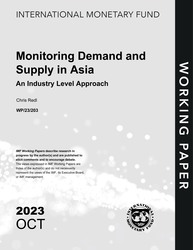
Monitoring Demand and Supply in Asia: An Industry Level Approach
Monitoring Demand and Supply in Asia: An Industry Level Approach
READ MORE...
Volume/Issue:
Volume 2023
Issue 203
Publication date: October 2023
ISBN: 9798400256639
$20.00
Add to Cart by clicking price of the language and format you'd like to purchase
Available Languages and Formats
| English |
Prices in red indicate formats that are not yet available but are forthcoming.
Topics covered in this book
This title contains information about the following subjects.
Click on a subject if you would like to see other titles with the same subjects.
Inflation , Economics- Macroeconomics , Economics / General , Inflation , Demand , Supply , Machine Learning , Spillovers , inflation decomposition , demand and supply shock , GDP shock , demand and supply movement , growth spillover , Supply shocks , Deflation , COVID-19 , Asia and Pacific , Europe , Global
Summary
This paper provides a decomposition of GDP and its deflator into demand and supply driven components for 12 Asian countries, the US and Europe, following the forecast error-based methodology of Shapiro (2022). We extend that methodology by (1) considering a wide range of statistical forecasting models, using the optimal model for each country and (2) provide a measure idiosyncratic demand and supply movements. The latter provides, for example, a distinction between aggregate demand driven inflation and, inflation driven by large shocks in only a small number of sectors. We find that lockdowns in 2020 are explained by a mix of demand and supply shocks in Asia, but that idiosyncratic demand shocks played a significant role in some countries. Supply factors played an important role in the post-COVID recovery, primarily in 2021, with demand factors becoming more important in 2022. The mix of shocks during the sharp increase in inflation in 2021-22 differs by country, with large and advanced economies generally experiencing more supply shocks (China, Australia, Korea), while emerging markets saw significant demand pressures pushing up prices (Indonesia, Malaysia, Philippines, Vietnam, Thailand). We illustrate the usefulness of the industry level shocks in two applications. Firstly, we consider whether industry supply shocks have created demand-like movements in aggregate prices and quantities, so-called Keynesian supply shocks. We find evidence for this mechanism in a minority of countries in our Asia sample, as well for Europe and the USA, but that these results are driven by the COVID-19 event. Secondly, we use the granularity of the industry shocks to construct country-level GDP shocks, driven by idiosyncratic movements at the industry level, to study cross country growth spillovers for the three large economic units in our sample: China, Europe and the US.
Copyright © 2010 - 2025
Powered by:
AIDC



